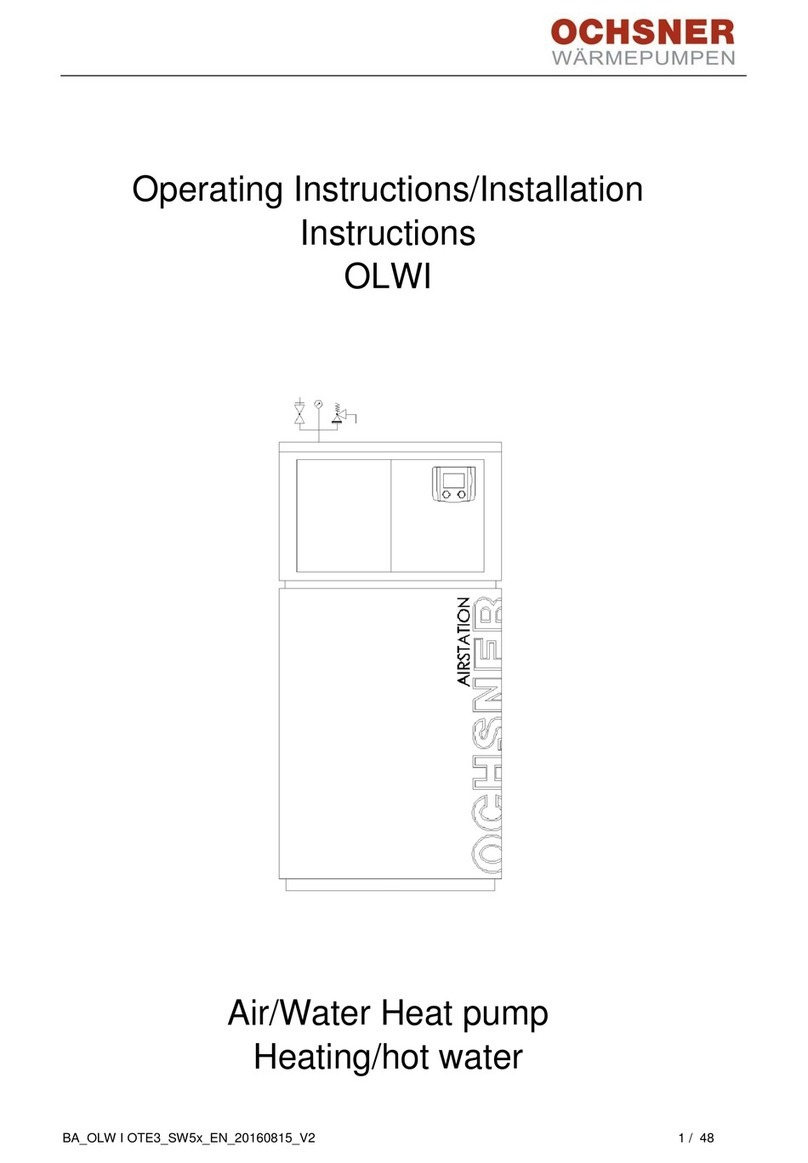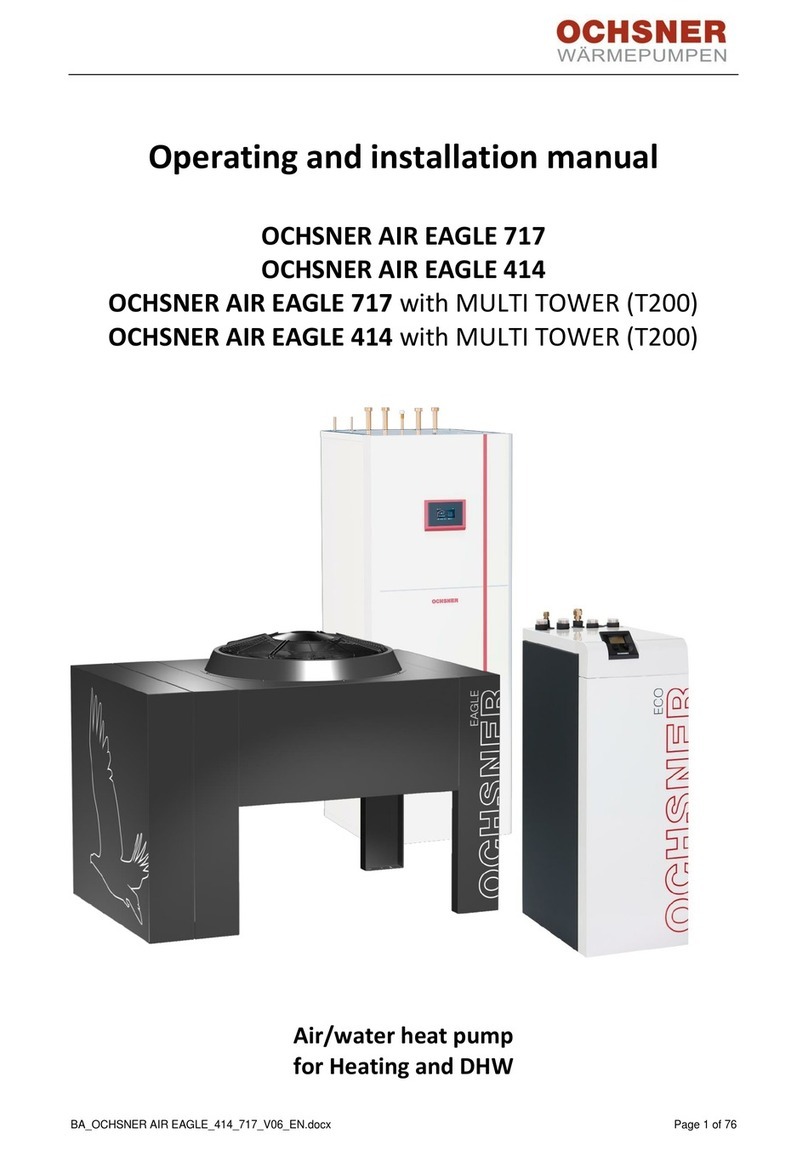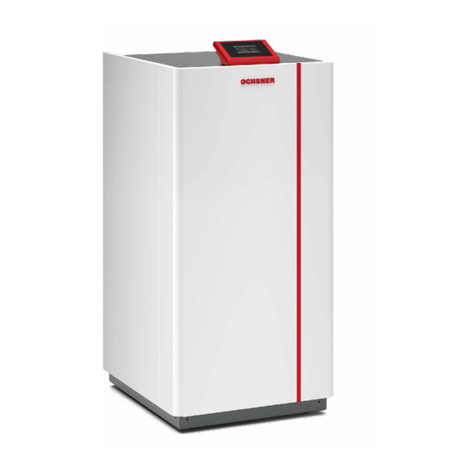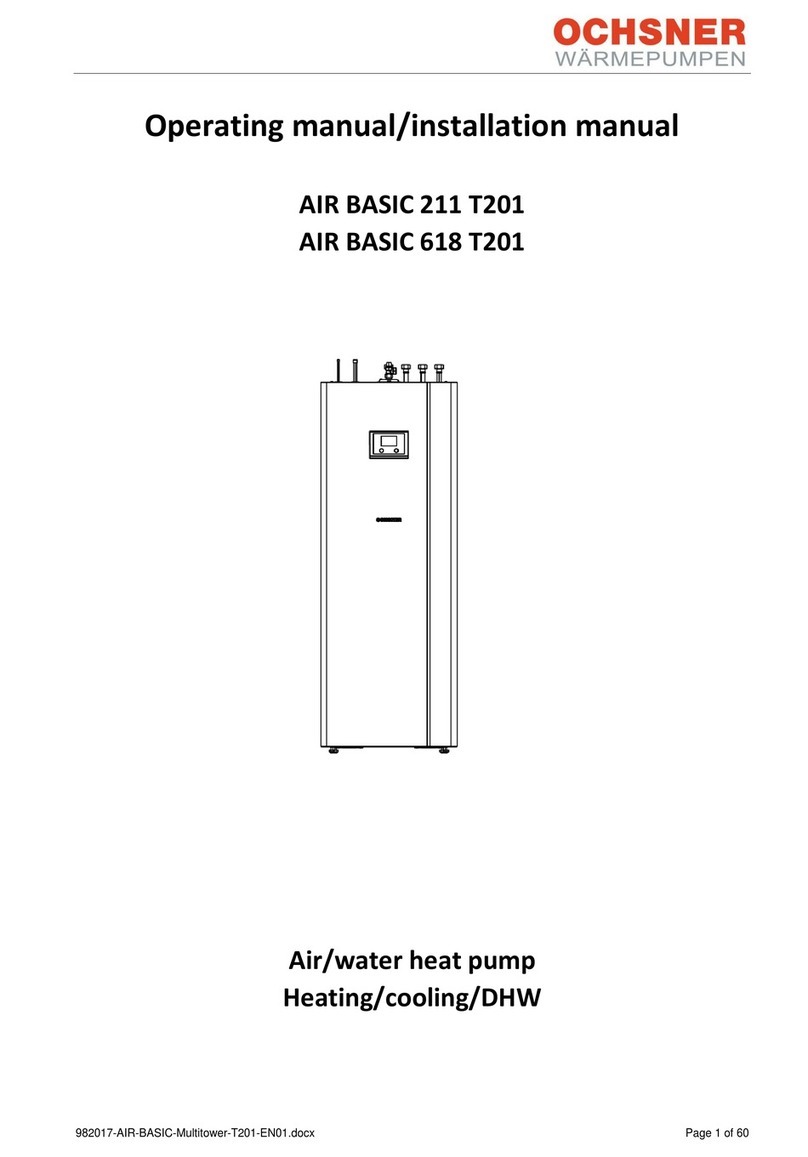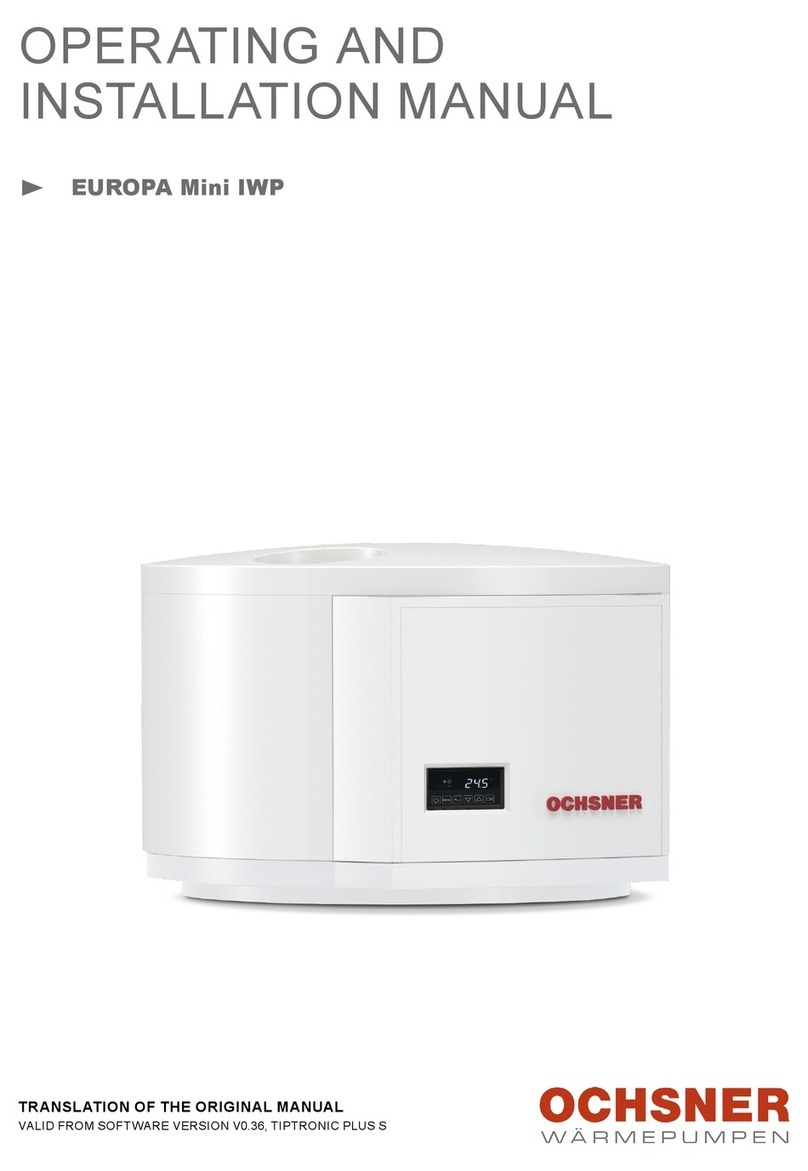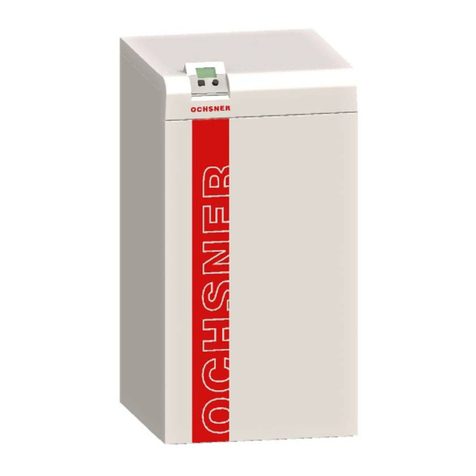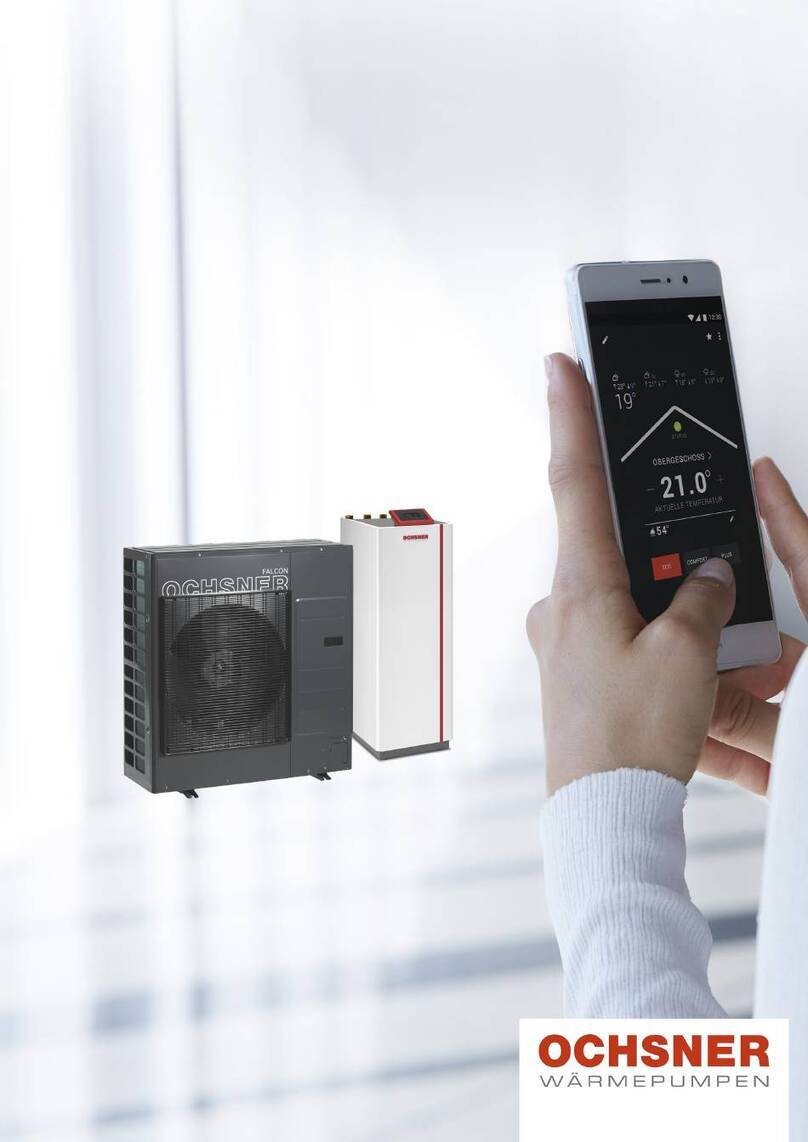
PIA-982043-AIR FALCON-T200-ih-EN | www.ochsner.com 3
CONTENTS
PLEASE NOTE
1. Information on documentation 4
1.1 Safety information 4
1.1.1 Arrangement of safety information 4
1.1.2 Symbols and possible dangers 4
1.1.3 Keywords 5
1.2 Other symbols 5
1.3 Units of measurement 5
1.4 Specied performance gures 5
2. Safety 6
2.1 Intended use 6
2.2 General safety information 6
3. How split systems work 8
4. Device description 10
4.1 Scope of delivery 10
4.2 Indoor unit hydraulics 10
4.3 Appliance components 10
4.3 .1 Indoor unit 10
4.3.2 Outdoor unit 11
4.3.3 Heat pump control unit 12
4.4 Name plate 12
ENGINEERING OF A SPLIT SYSTEM
5. Outdoor unit 14
5.1 Installation location 14
5.2 Minimum clearances 14
5.3 Foundations for the outdoor unit 14
5.4 Sound 15
6. Refrigerant lines 16
6.1 Preparing the refrigerant lines 16
6.1.1 Line lengths 16
6.1.2 Refrigerant pipes passing through open air 17
6.1.3 Underground refrigerant pipes 17
6.2 Wall conduit 18
7. Indoor unit 19
7.1 Installation location 19
7. 2 Keep minimum clearances 19
8. Machine-specific engineering and preparation
20
8.1 Outdoor unit 20
8.1.1 Installation location 20
8.1.2 Minimum clearances 21
8.1.3 Installation in coastal areas 22
8.1.4 Foundations for the outdoor unit 22
8.1.5 Wall mounting 24
8.1.6 Installing on at roofs 24
8.1.7 Drainage 25
8.2 Refrigerant lines 25
8. 2.1 Line lengths and height dierentials 25
8.2.2 Refrigerant line routing on outdoor unit 25
8.2.3 Material requirements 26
8.3 Indoor unit 27
8.3.1 Minimum clearances 27
8.3.2 Minimum area of clear oor space in the installation room
27
8.4 Preparing the electrical connections 27
8.4.1 Heat pumps for three-phase power supply 28
8.4.2 Heat pumps for single-phase power supply 29
8.4.3 Fuse protection 29
8.4.4 Cables from main distributor to indoor unit 29
8.4.5 Cables to sensors and actuators 29
8.4.6 Lines to the outdoor unit 29
8.4.7 Temperature sensor 29
8.4.8 Pumps and servomotors 30
8.4.9 PSU signal contact 30
8.4.10 Smart grid 30
8.4.11 High limit safety cut-out (STB-PUM-HK1) 30
8.4.12 Outdoor unit hardware shutdown (WQA-ERR-SIG) 30
INSTALLATION
9. Appliance installation 32
9.1 Installation of indoor unit 32
9.1.1 Delivery and transportation 32
9.1. 2 Positioning the appliance 33
9.1.3 Disassembling the appliance casing 33
9.1.4 Assembling the appliance casing 34
9.1.5 Separating the appliance sections 34
9.1.6 Assembling the appliance sections 35
9.2 Installing the outdoor unit 36
9.2.1 Delivery and transportation 36
9.2.2 Positioning the appliance 37
9.2.3 Drainage 37
9.2.4 Disassembling the appliance casing 37
9.3 Connecting the heat sink system 38
9.3 .1 Connecting the heating system 38
9.3.2 Quality of heating water 39
9.3.3 Heating system safety valve drain 39
9.3.4 Filling the heating system 39
9.3.5 Cooling version 40
9.3.6 Connecting the DHW 40
9.3.7 DHW system safety valve drain 41
9.3.8 Filling the DHW tank 41
9.4 Venting the appliance 41
9.5 Heating circuit with mixing valve 42
10. Electrical connection 42
10.1 General 42
10.2 Electrical connection of the indoor unit 42
10.3 Electrical connection of the outdoor unit 45
10.4 LAN connection 45
11. Initial start-up 46
11.1 Before initial start-up 46
11. 2 Testing the control circuit 46
12. Completion and commissioning 48
12.1 Requirements 48
12.2 System completion 49
12.3 Commissioning the system 49
12.3.1 Activities carried out by OCHSNER 49
SPECIFICATION
13. Data table 52
13.1 Controller outputs 55
13.2 Flow rate 55
13.3 Temperature sensor pressure drop curve 55
13.4 DHW heat input 55
14. Pump curve 56
14.1 Buer charging pump 56
14.2 Heating circulation pump 56
15. Limits of use for heating 56
16. Limits of use for cooling 57
17. Performance diagram 57
18. System principle schematic 58
19. Voltage quality in isolated mode 60
20. Dimensions and connections 61
20.1 Indoor unit 61
20.1.1 T200 61
20.1.2 T201 62
20.2 Outdoor unit 63
20.2.1 Drainage plug 64
ENVIRONMENT AND RECYCLING

